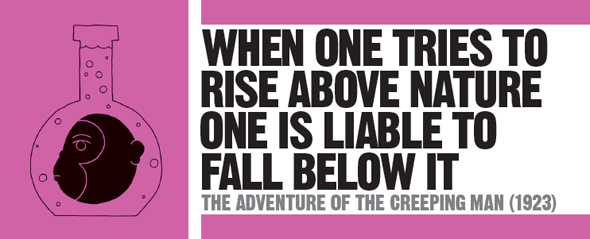
IN CONTEXT
Short story
UK: March 1923
US: March 1923
The Case Book of Sherlock Holmes, 1927
Professor Presbury Eminent physiologist at the University of Camford.
Trevor Bennett Professional assistant, lodger, and future son-in-law of the professor.
Edith Presbury Daughter of the professor, and Bennett’s fiancée.
H. Lowenstein Prague-based physiologist.
A. Dorak Lowenstein’s agent in London.
Set in 1903, shortly before Holmes’s retirement, this story is prefaced with some interesting reflections from Watson about the role he has played in the great detective’s brilliant career; the doctor fully acknowledges that his methodical and literal ways of thinking may be irritating, but considers that they have acted as a foil and a stimulant to Holmes’s roving imagination.

Jeremy Brett, Edward Hardwicke, and Colin Jeavons star as Holmes, Watson, and Lestrade, respectively, in this scene from the 1991 ITV adaptation of “The Creeping Man.”
A creepy case
The client in this case is Trevor Bennett, who is concerned about his employer, and presents Holmes with a number of details about Professor Presbury, a 61-year-old widower. The professor has recently fallen passionately in love with a young woman in her twenties, but she rejected him because of his age. Presbury then took a mysterious trip to Prague, and has been in an uncharacteristically irascible and aggressive mood ever since. His once-devoted dog is now agitated by its master’s presence, attacking him twice. Finally, the professor’s terrified daughter has spotted him in the middle of the night, “creeping” around, animal-like, on his hands and knees, along the landing.
Brushing aside Watson’s medical diagnosis of lumbago, Holmes suspects that something more interesting is afoot. Bennett has recorded that every nine days, the professor receives a package from a Bohemian dealer in London, which he will not let him open. The professor’s fits of rage and vigor follow the arrival of the package, so Holmes concludes he is obtaining some sort of drug from Prague.
When, following the nine-day cycle, Holmes and Watson travel to meet the professor at his university, he is instantly overcome by an alarmingly violent rage; Holmes also observes that the man’s knuckles are “thick and horny.” One night, during a clandestine observation of the professor’s movements, the duo watch in alarm as he squats on all fours, and then, with amazing agility, scales the ivy that grows on the side of his house. He is a sinister, terrifying apparition, “with his dressing-gown flapping on each side of him… like some huge bat….” He then torments and taunts his chained wolfhound, until the animal breaks free and bites his master’s throat. Bennett manages to calm the dog, and he and Watson dress the professor’s injuries.
"In all our adventures I do not know that I have ever seen a more strange sight."
Dr. Watson
An unnatural solution
Holmes deduces that the professor, madly in love and conscious of his advanced years, has made contact with an experimental scientist in Prague, who has been sending him samples of a rejuvenating serum. They find a letter with a Prague postmark from an H. Lowenstein, which confirms that his “wondrous strengthgiving” serum is extracted from a black-faced langur, a kind of Himalayan climbing monkey. Lowenstein has been supplying it to the professor via a third party in London, a Mr. A. Dorak. Recklessly, the professor has attempted to manipulate nature, halt the aging process, and revive his waning powers. During the course of this dangerous experiment, however, he has taken on the characteristics of an aggressive primate. His own dog attacked him because its natural instincts alerted it to the danger.
The surreal spectacle of the professor’s apelike behavior prompts Holmes to warn of the risks of scientific experimentation that distorts the “natural order.” The story also explores the necessity of accepting that everything comes to an end—that youth disappears, and the more sedate pleasures of old age must be embraced. The advances of modern science may be enlisted to hold back the tide, but ultimately everyone shares the same fate. It is a lesson that Holmes must learn too, as he contemplates retiring to what he calls “that little farm of my dreams.”
SCIENCE FICTION

In the late 19th and early 20th centuries, a number of writers were beginning to explore various speculative themes that were to become the preoccupations of later science fiction: time travel, lost worlds, utopianism, and ambitious scientists. The works of Jules Verne, H. G. Wells, and Edgar Rice Burroughs were to prove enduringly popular. Conan Doyle himself turned his talents to science fiction, writing a series of stories charting the adventures of Professor Challenger, who leads exhibitions into the unknown, discovers dinosaurs living deep in the South American rain-forest, and wrestles with the imminent extinction of the Earth as it is threatened by poisonous ether from outer space.
“The Creeping Man”, which was, in part, influenced by 1920s research into the rejuvenating effects of implanting monkey glands into humans, explores the consequences of reckless scientific experimentation. Presciently, it is also relevant to 21st-century fears about genetic mutation and eugenics.
